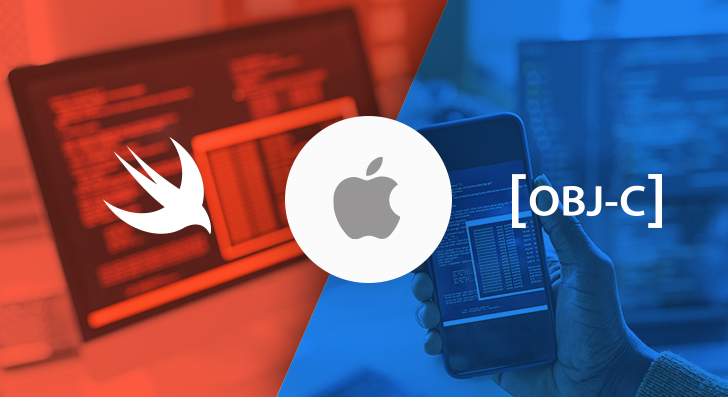With over 1.382 billion active iPhone users worldwide, it’s no wonder that the realm of iOS has been constantly expanding with exponential growth opportunities for businesses both large and small alike. As of March 2025, there are around 1.96 million apps available for download on the Apple App Store. In other words, Apple’s iOS has captured a market share of 18.25% worldwide as of February 2025. This clearly indicates that iOS app development is a strategic imperative for businesses striving to navigate the mobile application landscape. However, when it comes to developing an iOS application, the dichotomy between Objective-C and Swift represents a critical crossroads for mobile app developers, IT managers, CTOs, and other decision-makers.

Before embarking on the journey of iOS app development for crafting the digital experiences that users will love, it’s pivotal to understand that choosing a programming language is not merely a selection of syntax and semantics. Instead, it’s about choosing a path that will influence the user experience of mobile apps, impact the efficiency of the development team, and redefine the overall growth trajectory of a business. To conquer the iOS app landscape and drive organizations to new heights of success, go through this head-to-head comparison between Swift and Objective-C to make an informed decision. Let’s get started.
A Brief Synopsis of Objective-C
Objective-C is an object-oriented programming language developed in the early 1980s by Brad Cox and Tom Love as the extension of C. This high-level general-purpose language comes with a shallow learning curve and has been promoted by Apple since the 90s for developing macOS and iOS applications. It combines the properties of two earlier programming languages namely, Smalltalk and C, making it an extensive, complex syntax. The C language provides the non-object syntax, while the object syntax comes from Smalltalk.
A Brief Synopsis of Swift
Swift is a relatively new general-purpose programming language developed by Apple Inc. and the open-source community. The development of this high-level language started back in 2010 and was made accessible to the public four years later in 2014. Though the basic concepts of this open-source language are similar to Objective-C, it embraces the features of modern programming languages, which in turn, makes it a coveted choice that supports development in macOS, iOS, watchOS, tvOS, and pdOS environments.
Reason Why Swift is Preferred for iOS App Development
Swift vs Objective-C for iOS Apps: A Head-to-Head Comparison
Both Swift and Objective-C are extensively used for developing iOS and macOS applications. Listed below are the key differences between the two.
| Basis Of Comparison | Swift | Objective-C |
|---|---|---|
| Syntax | Simple, easy to learn, and intuitive | Utilizes parentheses and symbols |
| Performance | High performance and is ideal for performance-sensitive coding | Runtime code compilation is slow |
| Code Safety | Quick bug recognition and fixing | Developers are less likely to notice mistakes |
| UI Development | Simplifies UI creation with modern tools like SwiftUI | Relies on traditional methods, requiring more effort |
| Learning Curve | Easier to learn for new developers due to clean syntax | Steeper learning curve due to complex structure |
| Development Environment | Xcode, Swift Playground, Cocoa Touch, and more | Mainly Xcode |
| Memory Management | Uses Arc that supports all APIs | ARC is only supported within Cocoa API |
| Libraries Support | Supports the integration of dynamic libraries | No support for dynamic Libraries |
| Stability | Stable but it’s growing as constant improvements are released | Highly Stable |
| Legacy Code Compatibility | Limited support for older codebases | Fully compatible with legacy Objective-C projects |
| Development Speed | Requires less code, making development faster | Requires more code, slowing down development |
| Community Size | Larger and growing developer community | Smaller, stable developer community |
Swift vs Objective-C: Pros and Cons
Advantages of Objective-C
1. Compatibility with Existing Code
Objective-C’s compatibility with existing codebases is a significant advantage for iOS developers working on maintaining older iOS applications or legacy projects. This high-level general-purpose language allows an iOS application development company to seamlessly extend and integrate code written in Objective-C with modern components. This level of interoperability enables businesses to continue to maintain and modernize their existing applications without having to rewrite them completely. In other words, the interoperability offered by Objective-C is beneficial when dealing with established and large applications or when businesses need to maintain their applications that were initially developed in Objective-C.
2. Tried and Tested for Decades
Objective-C has been around for several decades and used extensively for writing millions of lines of code since its initial release to this day. The best part is that there is an answer available to almost every question related to Objective-C, all thanks to the exhaustive documentation that exists.
3. Dynamic Runtime Behavior
It allows app behavior to be determined at runtime rather than during compilation. This flexibility enables dynamic adjustments and enhances app functionality without needing to recompile the code. It also supports object manipulation, which is useful for complex applications requiring runtime adaptability.
4. Extensive Libraries and Frameworks
It has access to numerous external libraries and frameworks. This simplifies development tasks by lowering the need for manual coding. These tools also provide solutions to common iOS app development challenges.
5. Stability
It is a mature and stable language that hardly undergoes frequent changes. This eliminates the need for constant updates and reduces migration costs over time. As a result, developers can focus on improving existing iOS applications.
6. Proven Reliability in Enterprise Systems
It has been used in enterprise applications for years. This demonstrates its reliability in large-scale systems that require robust performance. Furthermore, its reliable track record ensures that developers can trust it for crafting robust and stable iOS applications.
7. Strong Community Support
Objective-C is backed by a significant community of developers that makes it easier to find solutions to common problems. The community provides valuable resources for code, best practices, and sharing knowledge via documentation, online tutorials, and open-source projects written in Objective-C. This exhaustive support can be advantageous, especially when encountering challenges during mobile application development. Furthermore, Objective-C frameworks and libraries are still accessible and relevant, though not as actively maintained as their Swift counterparts. This helps developers reduce both time and effort, especially when working on complex tasks.
Disadvantages of Objective-C
1. Verbosity
Objective-C is known for its verbosity, which simply means that iOS developers need to write several lines of code to accomplish the same task. This makes application code harder to read and maintain.
2. Slower Development
Due to its verbosity and complex syntax, app development in Objective-C can be comparatively slower and requires more effort in terms of code writing and debugging.
3. Decreasing Popularity
Apple actively promotes Swift as the future of iOS application development; owing to this, the popularity of Objective-C is declining rapidly. In other words, businesses that prefer Objective-C for their app development project may find themselves with limited access to new resources and tools, potentially making it challenging to stay updated with the latest iOS mobile application development practices.
4. Limited Developer Community
The number of skilled developers is shrinking faster as new developers focus on learning Swift. As a result, companies may face challenges in finding skilled professionals for iOS development with Objective-C.
5. Outdated Features
It lacks many modern features like type safety and error handling that Swift offers. This makes it less efficient for building robust and scalable applications.
6. Steep Learning Curve
It is harder to learn due to its complex syntax and older programming style. This makes it less appealing to new developers entering the iOS app development realm.
7. Security Concerns
Objective-C apps are easier to reverse engineer compared to Swift apps, making them more vulnerable to hacking and security breaches.
How Outsourcing Mobile App Development Drives Growth for Startups
Advantages of Swift
I. Faster Development
The clean and concise syntax of this open-source language simplifies iOS application development, making it a coveted choice among developers of all levels of expertise. The language’s simplicity, combined with ample documentation and community resources, makes it a preferred choice for businesses looking for quick mobile app development.
II. Safety and Reliability
Swift is designed to help developers write reliable code. It prevents common mistakes and makes apps more stable. Swift encourages using immutable variables and constants to prevent accidental changes to data, making the code more predictable. It also helps control who can access the code, keeping sensitive information safe.
III. Community Support
Swift is open-source in nature, which enables developers to contribute to it. This leads to the development of new tools that help with iOS development. Businesses benefit from the open-source model since they can access modern tools without extra costs. The community’s contributions make Swift better and more compatible with different use cases.
IV. Fast and Efficient
Swift is designed to be fast. It’s much faster than Objective-C since it generates efficient code. Swift uses advanced techniques to make apps run quickly and smoothly. It also optimizes code to reduce delays, making apps perform better.
V. Best Suited for High-Performance Applications
Swift is optimized for speed, which simply means that mobile applications written in this programming language tend to consume fewer system resources and run faster. This is pivotal for resource-intensive applications, such as multimedia or gaming apps, where performance plays a critical role. Furthermore, factors such as a modern runtime, efficient handling of data types, and better memory management through ARC are accountable for Swift’s performance improvements. This makes it a preferred choice among enterprises for developing high-performance iOS applications.
Disadvantages of Swift
I. Limited Talent Pool
Though the popularity of Swift is growing rapidly, it still has a smaller talent pool compared to Objective-C. Many seasoned developers have rich experience and expertise in Objective-C since it was the standard language for iOS mobile application development for many years. Finding experienced developers with a deep understanding of this open-source programming language and its nuances can be time-intensive and challenging.
II. Issues with Binary Compatibility
Code compiled with different versions of Swift may face problems due to binary compatibility issues, complicating dependency management within projects.
III. Learning Curve for Teams
Although it is easy to learn, developers unfamiliar with the language may require time to adapt. This delays project timelines.
IV. Challenges with External Integration
Frequent updates in Swift often cause compatibility issues with external tools and frameworks, making integration more difficult.
V. Not a Reflective Language
Unlike Java, Swift lacks reflection capabilities, which limits its ability to manipulate objects dynamically during runtime.
VI. Instability Due to Frequent Updates
Swift is considered a “moving target” because of its frequent updates. These updates sometimes introduce issues with external tools and IDEs, making iOS development with Swift less stable.
VII. Speed Concerns in Early Versions
Earlier versions of Swift faced performance issues compared to Objective-C, although newer releases have improved significantly.
Swift or Objective-C for iOS Development: Which Language to Choose
Swift is a modern, flexible, and versatile language that offers several advantages, making it a popular choice for developing iOS applications.
When to Choose Swift for App Development
- When creating a new project from scratch
- When there is a tight deadline
- When better code safety is required
- When interoperability with objective-C is required
- When there is a need to build a future-ready iOS mobile application
- When the iOS app development project requires high performance and speed
Objective-C is a matured programming language that has been around for several decades. Listed below are the reasons to consider Objective-C for developing iOS mobile applications.
When to Choose Objective-C for App Development
- When the app development project is complex and large
- When the iOS application is already built in Objective-C
- When working on legacy projects
- When runtime dynamism is needed
- When compatibility with older iOS versions is needed
- When stability is a priority
- When interoperability with C/C++ code is required
- If C++ or C third-party frameworks are used across the mobile application
Summing Up
As we conclude the detailed comparison between Swift and Objective-C, it’s important to note that there is no one-size-fits-all approach when it comes to choosing a programming language for iOS mobile application development. Each language comes with its own strengths, challenges, and nuances, and the decision to choose a language should be a reflection of your project’s unique requirements, your team’s development expertise, and your future aspirations. Hopefully, after reading this detailed insightful piece, you’ll have the insights needed to choose the right programming language to bring your iOS mobile app vision to life.





